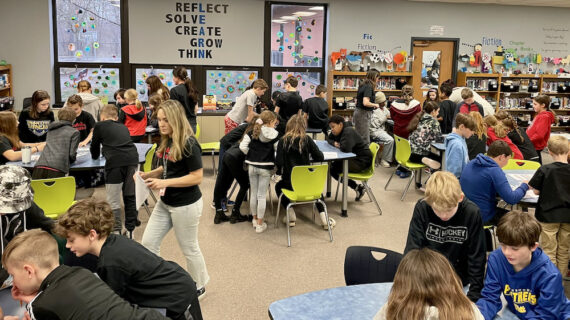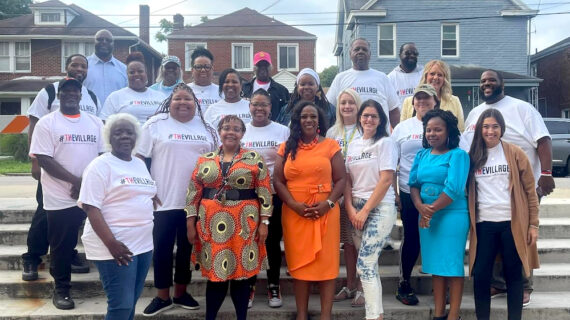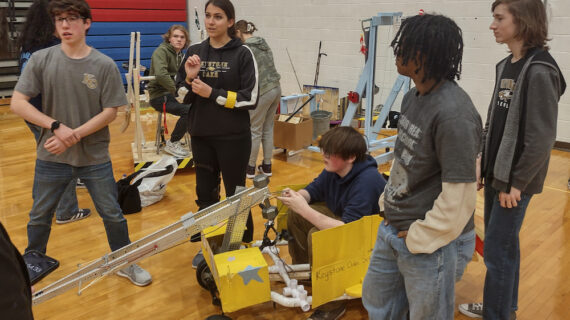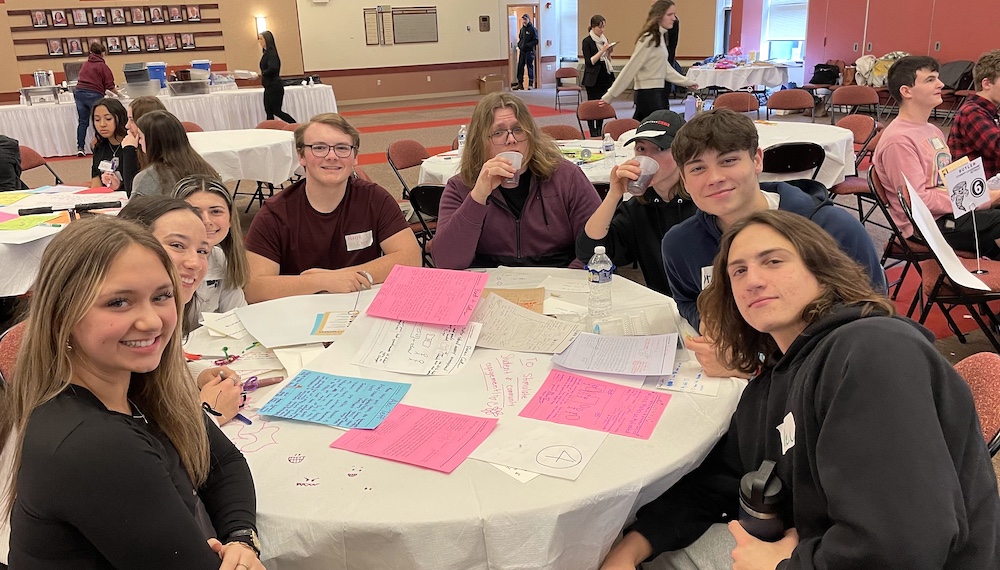
In the Butler Area School District, students are helping chart the future
This story is one in a series created in collaboration with the AASA Learning 2025 Alliance to celebrate the work of groundbreaking school districts in the Pittsburgh region. Kidsburgh will share these stories throughout 2024.
What makes a student leader? At Butler Area School District, the definition is a broad one — and deliberately, mindfully so.
In January, Butler teachers and administrators gathered a group of about 100 students without telling them what was going on. The kids — a strategically chosen mix of honors students, athletes, vo-tech participants, and others — all asked Principal Jason Huffman the same question: “Why are we all in the same room?”
It turns out they’d been tapped to drive a next-generation project, kicked off by a Little Learning Science Bet grant from The Grable Foundation, designed to identify ten ways to make their school and community a better place to grow up.
It’s Butler Area’s version of an all-state, all-star team: students drawn from all corners of the community to generate ideas more innovative and powerful than anyone could devise alone. But they’re not just imagining. Working closely with school staff and community leaders, these teens will drive their initiatives forward.
“We’re trying to weave them together,” says Superintendent Brian White. “They will have a real voice in all of this.”
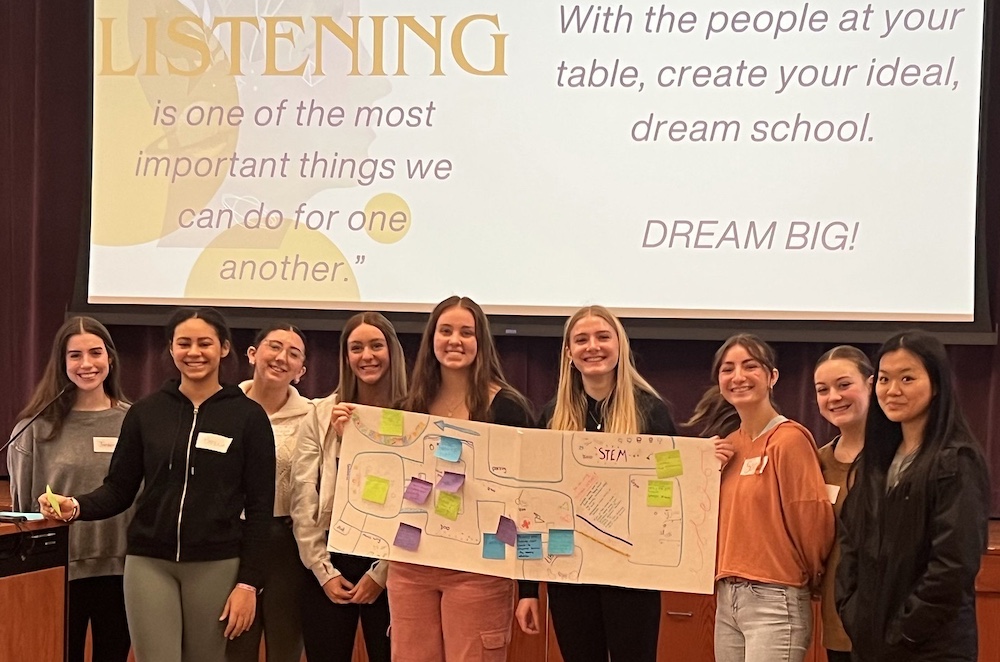
The planning started almost instantly. Within minutes of learning why they were in the room, the kids got down to business and started brainstorming. The goal — helping the school and community really thrive — was one they were ready to tackle.
HOW IT WILL WORK
Butler is part of the Western Pennsylvania Learning 2025 Alliance, a regional cohort of school districts working together — with support from The Grable Foundation — to create student-centered, equity-focused, future-driven schools. Led by local superintendents and AASA, The School Superintendents Association, the Alliance convenes to help districts like Butler do what they do best: help kids build the brightest possible future.
This initiative was designed with that student-centered, equity-focused future squarely in mind.
“We wanted to create something where the students could take more ownership in the building,” says Katie Black, orchestra director at the intermediate and high schools and one of the teachers guiding the project.
But which students? At many schools, those with visible leadership qualities — extroversion, athletic ability, academic accomplishment — tend to drift toward the front row of such projects. At Butler, they were included, but teachers also welcomed kids whose leadership potential might be a bit less obvious or take different forms.
“It was not homogeneous at all,” says Emmalynne Waseleski, the district’s choral director and another teacher supporting the project.
“We made it clear to our staff that we wanted everything from honors and gifted students all the way to students in basic-level courses,” she says. “We didn’t want to be missing any facets in our school. We want everyone to be represented.”
They brought together “all different kinds of students that display some level of leadership quality,” Black says, so they could take center stage.
And the staff? Their role is to create the conditions for creativity, then get out of the way.
During a day-long planning event, Waseleski says, “It was not about any of the adults in the room. It was about how they could make the school district what they feel it needs to be for them to best learn and become future citizens.”
Together that day, the students focused on a single mandate: Design your dream school. They generated ideas, independently and in groups, thoughtfully combining some and discarding others until they had a good group of about ten goals.
The wide-ranging slate of initiatives includes:
- Increasing awareness of what’s happening at school. The district offers many activities and scholarships but many students are unaware. This will help connect students with things that interest them.
- Repurposing space. What if unused lockers in a hallway were removed and the space filled with inspiring murals or flexible seating? These students want to make their building more useful — and more beautiful — in new ways.
- Planning for the future. “Future planning is not the same future for everyone,” White says. But no matter their path, students want help connecting with higher education, workforce training, and networking opportunities.
- Making school a healthier space. The students envision a cleanliness collaboration with the custodial staff, indoor beautification, and ramping up the presence of art within the school.
- Creating a more inclusive environment. These student leaders want everyone to feel welcome and accepted, and to create opportunities for all students to interact and support each other.
- Making mental health a priority. This is a hallmark of the generation now in high school, and is more relevant than ever after the COVID-19 pandemic.
These and other goals emerged from that first full day of brainstorming. In the process, something else happened, too: This diverse group found common ground.
“Suddenly,” Waseleski says, “it didn’t matter that you were academic or you were honors, because a lot of the dreams were beginning to intertwine. Or if they didn’t, the students were like, ‘Oh, I want that dream!’ So it opened their eyes to ‘Okay, we’re all in this room for a collective reason, and we didn’t realize that — and we have things in common.’”
In the hands of these students, what might the future of the Butler Area School District hold? That part is still coming into focus. But one thing has emerged as definite: The vision put forth is different, forward-looking — and clearly the property of the rising generation that is dreaming it up.
“It’s their idea,” says Black. “Now they can take ownership and really buy into it.”
Want to download this story? Click here for a PDF.

